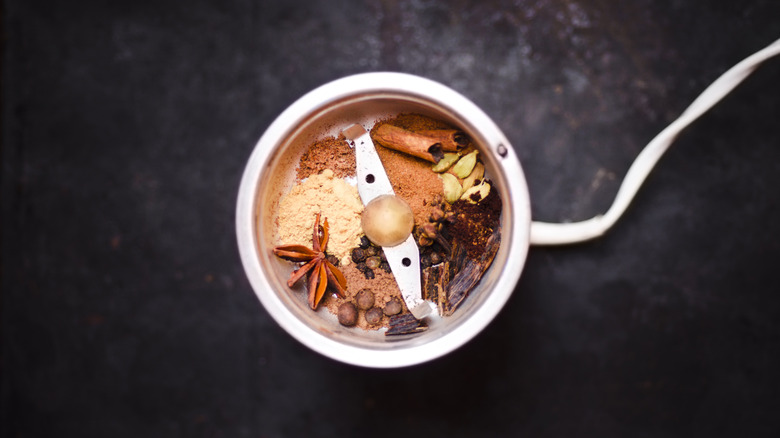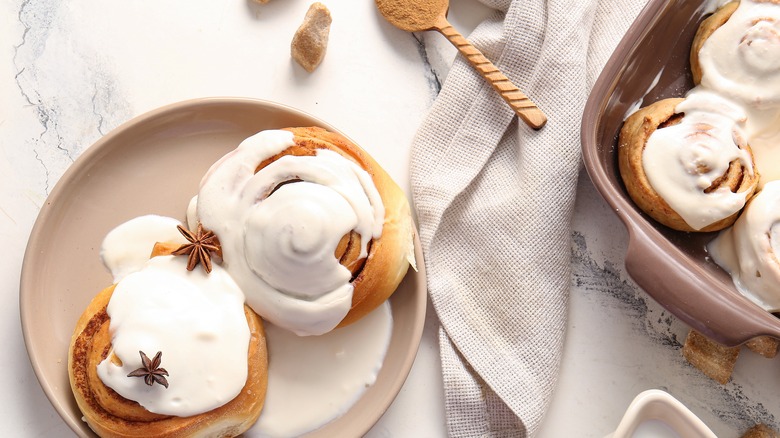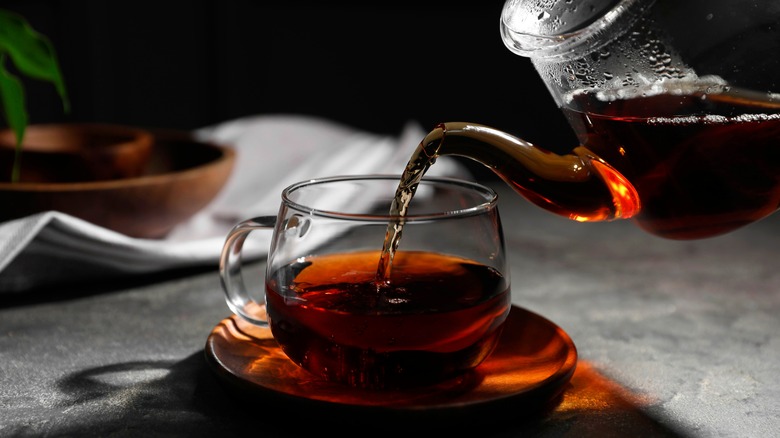12 Tips For Baking With Chai Spices
We may receive a commission on purchases made from links.
With sugar, spice, and everything nice, recipes for chai-infused baked goods are unfailing. The warm flavors of cardamom, cinnamon, and cloves are oh-so comforting when temperatures start to drop. But is that brittle cinnamon stick from yesteryear still okay to use? What other spices make up masala chai, and what's the best way to jazz things up this season?
As a lover of autumn flavors, I pondered these questions, but I'm far from a professional baker. Baking is particularly tricky where I live (a mile above sea level), and I prefer to leave things to the experts. Fortunately, there are plenty of phenomenal bakeries in Denver, and for this article, I consulted two local industry leaders.
Saura Kline is the head pastry chef at Local Jones, the swanky Halcyon hotel's signature restaurant in Cherry Creek. Kline is also the author of "The Essential Pie Cookbook: 50 Sweet & Savory Recipes," and she has a chai-spiced apple pie that will blow you away.
I also spoke with pastry chef Lillian Lu, whose professional resume includes Michelin-star restaurants such as Daniel and Aquavit. Today, she co-owns Michelin-recommended Noisette Restaurant & Bakery which makes some of the Highland neighborhood's most mouthwatering bites.
Without question, these talented experts know their stuff. So without further ado, throw on your apron and start taking notes. These are the essential tips you need when baking with chai spices.
Experiment outside the traditional spice blend
Masala chai has medicinal origins and was first brewed in India thousands of years ago. In its traditional form, many regard it as an Ayurvedic drink that promotes proper digestion — one of the age-old medical system's key pillars for good health.
However, what qualifies as "traditional" is tough to say. Even early chai spice blends varied, with regions throughout India adopting different styles. For example, consider masala versus Irani chai. Americans are most familiar with the former, which often includes green cardamom, nutmeg, ginger, cloves, star anise, and cinnamon. Irani chai – popular in the Indian metropolis of Hyderabad — often requires just cardamom pods.
Meanwhile, other regions of India have expanded upon the typical spice mix, adding ingredients like lemongrass, saffron, fennel seeds, and tulsi, an Ayurvedic herb also known as holy basil. Like many ancient recipes, time and place have altered what is authentic — but that's not to say new adaptations are any less delicious.
Lillian Lu says, "I use a mix of cinnamon, green cardamom, nutmeg, cloves, star anise, ginger, and black pepper." She adds that along with fresh ginger, the unique addition of freshly ground black pepper brings out the spiciness of the chai flavor. Meanwhile, Saura Kline leans into the warmth of masala chai with a sprinkle of allspice. You could also try infusing your chai spice mix with turmeric, anise, or a hint of vanilla to help soften the overall flavor.
Balance flavor with the right ratio of spices
When it comes to baking recipes, chai spices can often be tailored to personal preference. Lillian Lu explains, "If you want a more aromatic chai, I would use more cardamom, cloves, and star anise. For a spicier chai mix, I would add fresh ginger and more black pepper. For a mix with more depth, you can also incorporate different types of peppercorns, such as green or pink peppercorns."
However, balance is key to any recipe — and some of the spices found in masala chai blends can be quite potent. Saura Kline reminds bakers to use cloves, nutmeg, and allspice sparingly, as they tend to overpower. Match them with a heavier dose of cinnamon, ginger, and cardamom for a rounded flavor.
You can use this maple chai recipe as a good rule of thumb, as it aligns perfectly with Kline's advice. It calls for four cardamom pods, one cinnamon stick, and a quarter-inch piece of ginger, plus three whole cloves and a pinch of nutmeg.
Start with whole ingredients rather than pre-ground spices when feasible
"I always recommend starting with whole spices for the cardamom, cinnamon, star anise, cloves, black pepper, and nutmeg," says Lillian Lu. She adds that when you incorporate ginger into a baking recipe, fresh ginger will add a punchier flavor than its dried and ground counterpart.
Lu continues, "Pre-ground spices tend to be less potent the longer they stay on the shelf, so grinding your own spices right before use will result in a much more aromatic and flavorful chai." But admittedly, not every home chef has the gear or the time. Plus, many of us already have a stocked spice rack ready for use. Saura Kline isn't opposed to taking the shortcut but she does emphasize that your spice bottles should be no more than six months old for the best flavor. In other words, if you haven't touched that bottle of ground cloves since last Thanksgiving, toss it and buy new whole cloves instead.
Toast the spices to amplify flavor
If you opt for whole spices, Lillian Lu says that before grinding them, you should toast your spices to bring out a fresh and more potent flavor. She explains, "The best way to toast spices is on low heat, stirring often so the spices are evenly toasted. The low heat assures that the spices are toasted the entire way through and not just on the surface. It also prevents burning the spices which could impart a bitter flavor."
It's really that simple. However, here's another tip when cooking with spices: Make sure to toast smaller spices for less time. For example, when it comes to a chai spice blend, add the larger cinnamon sticks and star anise to your dry pan sooner than the tiny peppercorns and cloves. Note that the longer they toast, the stronger the flavor — but to Lu's point, don't take things too far as the result could be quite bitter. To help prevent this, stir the spices in the pan frequently and remove them from the hot surface once they reach a desired point.
Grind your spices very finely
After toasting your whole spices, they'll become more brittle and easier to grind. However, this isn't the time to break out your rolling pin and a plastic bag. Baking with chai spices requires a bit more precision.
Lillian Lu explains, "It's important to make sure that the spices are ground very finely. If the spices are too coarse, then the resulting baked good will not have a pleasant mouthfeel. The best way to achieve this is to use a spice grinder, then passing it through a fine mesh sieve."
If you don't have an electric spice grinder, there's an unexpected kitchen tool you can use to grind spices: a coffee grinder. In this case, you'd want to adjust the coarseness to an espresso grind, which is the finest option.
Note that if you plan to grind your entire spice rack this way, you may want a coffee grinder dedicated strictly to spices. But if you're only planning to pulse a chai spice blend, you might be able to get away with just one appliance. Those who enjoy a dirty chai latte would agree that the flavors of coffee and chai pair beautifully.
Combine chai spices with complementary ingredients
Chai spices marry well with an array of flavors. When baking, pair them with a punch of espresso, a drizzle of maple syrup, a healthy dose of chocolate, or a shot of booze. Saura Kline particularly recommends baking chai spices with bourbon, which amplifies both ingredients' warm and spicy qualities.
Kline adds that when baking, she also enjoys mixing chai spices with nuts like pecans, hazelnuts, and almonds. This combination is a classic — even some traditional Indian chai recipes call for nuts. For example, badam chai blends almonds and cardamom. The pink-hued Kashmiri chai, which hails from the Kashmir region between India and Pakistan, features cardamom and cinnamon, plus almonds and pistachios.
Another of Kline's favorite pairings is fruit. "I love combining chai spices with winter fruits such as apples and pears. They are very complimentary," she says. Cranberries also fit the bill and during the holidays, what would be more mouthwatering than a chai-spiced pumpkin pie?
Infuse chai spices into pie
Chai is one of the best spices to add to your pie crust, giving a recipe a greater warmth and depth of flavor. You can incorporate it into a flaky pie crust simply by whisking it in with the other dry ingredients. The same applies to cookie crusts, shortcrusts, and so forth.
However, Saura Kline's preferred method is to amp up the pie filling. She says, "I have a chai-spiced apple pie recipe that I love. I toss the apples with brown sugar and all my chai spices. During the hour and a half bake, all the spices infuse into the apples, making it a tasty pie in the end."
This concept can be adopted for a variety of recipes, so long as the pie filling is complementary to chai spices. If you're not sure what flavors will match well, any recipe that calls for chai spice ingredients is a green flag. Take, for example, this winter white chocolate cranberry tart recipe. It calls for cinnamon and ginger in its cranberry jam component, as well as nutmeg in the white chocolate ganache. Simply swap those spices for a chai spice blend at a one-to-one ratio and the result will be all the more delicious.
Mix chai spices into batter and dough
A pinch of cinnamon can transform your morning cup of coffee. But have you ever put a sprinkle on top only to get a powdery, not-so-pleasant sip? The trick is to incorporate the spice into your coffee grounds, which creates a smooth and consistent flavor. Baked goods work the exact same way.
Lillian Lu explains, "Chai spices are great when baking cakes, muffins, or cookies. The spices can be distributed evenly throughout the batter or dough so the flavor is present throughout."
The same applies to other recipes, too. For example, if you're making cinnamon rolls with this cozy spice blend, don't dust the top of the batch. Instead, blend it into the filling, the glaze, or even the dough itself. However, don't go overboard with all three — balance is key. In cases where you spice a batter or dough, Lu recommends pairing the baked good with a vanilla buttercream or cream cheese frosting, as the sweetness will complement the spices' warmth.
Upgrade creamy recipes with chai spices
For millennia in India, chai wasn't prepared with tea, milk, and sugar. But following British colonialism, this modern adaptation has become what many associate with the spice blend. Today, you'll find chai tea lattes on coffee shop menus around the world — and countless baking recipes take cues from the popular frothy beverage.
"I like to pair chai spices with something creamy," affirms Lillian Lu, and she's far from the only one keen on this combo. For instance, Tasting Table writer and professional pastry chef Katie Rosenhouse created a vanilla chai spice pudding with maple pecans recipe that's absolutely decadent. Butter, heavy cream, and whole milk provide plenty of creaminess, while sugar and pecans caramelized in maple syrup add a sweet factor to the chai-spiced dish.
The ultimate fall crème brûlée and this chai-spiced cheesecake recipe with cranberry compote further demonstrate that warm chai spices and sweet dairy goodness are a match made in heaven. Crack open a baking cookbook and you're likely to find a wealth of similar inspiration.
Liquid chai concentrate is a great ingredient substitute
"Using freshly ground spices will produce a more concentrated flavor of chai in [a] baked good," affirms Lillian Lu. The majority of pastry chefs agree, as this method is most common across the board. However, you may occasionally come across a recipe that calls for chai tea — as in, the spice blend mixed with black tea leaves. These recipes often instruct the baker to steep the tea in milk, which is then mixed into a batter.
However, as a former barista, I can assure you that this is not an effective brewing method. Lu recommends toasting chai spices to release their aromatic oils, and tea acts in a very similar way. You need heat to extract its full flavor and milk should never reach the point of boiling water, as this may scald the product and negatively affect flavor. Sure, you could brew the tea in cold milk for six hours but who realistically has the patience for that?
Cue liquid chai concentrate, a time-saver and flavor-booster. The easiest way to make chai concentrate at home is to use three bags of chai tea, or roughly six grams of looseleaf, per one cup of boiling water. Steep for four minutes, strain, and you're done!
Saura Kline says, "Liquid concentrate is strong enough to carry the chai flavor and is easily combined in a baked good." Lu agrees, specifying that it can simply replace some of the liquid in a cake or muffin batter.
Taste test to make sure you've used enough spice
The majority of chefs would agree that if you spend an hour in the kitchen without tasting anything, you're doing things wrong. How else will you know if you've added enough seasoning or if your pasta is al dente? Tasting between steps works with most styles of cooking, but baking is a different story — unless you're bold enough to eat raw eggs and flour. Personally, I wouldn't recommend it and neither would experts as these ingredients are known for their potential to carry dangerous pathogens like salmonella.
But still, a good home baker knows that trial and error are key to getting a recipe right. Saura Kline feels that when it comes to baking with chai spices, not using enough spice is an all-too-common mistake. "Make sure you use a combination of warm spices and enough of it," she affirms.
Reasonably, you may not want to lick the spoon. But Kline says, "Test the spice level with a small batch and adjust as needed to make sure the flavor comes through." In other words, if it's your first time making this chai chocolate chip banana bread recipe, consider cutting quantities and baking a mini loaf instead. Alternatively, conduct a real taste test by making a full batch of batter and filling four mini loaf pans, each with an incremental amount of spice. Just be sure to mark which one is which.
Don't forget a dash of salt
It's obvious that sugar is one of the ingredients every baker should have on hand. But Saura Kline understands the merit of balance. She says, "I'd like to stress the importance of putting salt in baked goods. This will ensure the flavor pops a little more." Those who have whipped up a batch of salted caramel or put a sprinkle of sea salt on chocolate chip cookies understand that salty-sweet combos are clear winners.
But even early chai connoisseurs knew that salt amplified flavor. Traditional Kashmiri chai has long been consumed in India and Pakistan, and it's also referred to as "noon" chai. In many Indian languages, "noon" translates to salt — and to no surprise, the beverage includes the umami-rich seasoning, plus plenty of cardamom, cinnamon, and perhaps other chai spices.
Additionally, a pinch of salt is the key to balancing out bitter tea. So if, for example, you made a batch of chai concentrate for baking and accidentally let it steep for too long, there's no need to fret. An extra pinch of salt will do just the trick and allow all of the sweet flavors in your baked good to shine.












